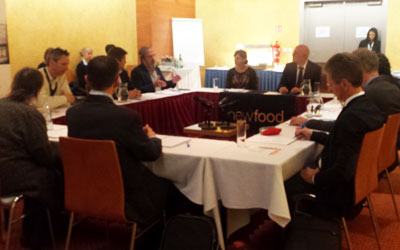Detection of residues and contaminants in food products and the development of novel approaches – RAFA roundtable
- Like
- Digg
- Del
- Tumblr
- VKontakte
- Buffer
- Love This
- Odnoklassniki
- Meneame
- Blogger
- Amazon
- Yahoo Mail
- Gmail
- AOL
- Newsvine
- HackerNews
- Evernote
- MySpace
- Mail.ru
- Viadeo
- Line
- Comments
- Yummly
- SMS
- Viber
- Telegram
- Subscribe
- Skype
- Facebook Messenger
- Kakao
- LiveJournal
- Yammer
- Edgar
- Fintel
- Mix
- Instapaper
- Copy Link
Posted: 17 November 2015 | Stephanie Anthony, Editor, New Food | No comments yet
From the 3rd – 6th November New Food had the pleasure of attending Recent Advances in Food Analysis (RAFA) 2015. While at this event, New Food hosted a filmed roundtable discussion, sponsored by Sciex, on the topic of contaminants and novel approaches in food analysis.




Bert Pöpping began the discussion, with the prediction of an increase in speed and sensitivity. The group all agreed that the technology would continue to advance – in regards to speed as well as sensitivity. Bert also suggested that there would be a “geographical divide between the industrialised countries and those which are not ndustrialised What do you think will drive these changes? On the topic of what would drive the food and beverage industry to change, in terms of food analysis, consumers were of course mentioned. “The consumer is able and willing to pay more – but wants authenticity and proof,” said Michael Rychlik – in this “finger printing systems will come to the fore”. We are much more aware now of what is in our food, and as consumers we want to know more. This thirst for knowledge is something that drives the industry, to be able to provide the correct information. There will be a broader spectrum of expertise – in the future citizens will be able to analyse food with their smart phones, so a whole range of unqualified data and a large spectrum of types of analysis. Jana Hajšlová suggested “we should bring the team competencies together, because in many cases when some food scandal appears it’s not only one compound; there is a lot of connected facts – we need rapid reports and collaboration of all stakeholders; you, us, consumers.” How is the use of software and data handling/processing influencing future trends in analytical protocols? The demand is for faster, more accurate systems in analysis; systems that can detect all contaminants at once, and perform a number of tasks at the same time. Paul Brereton made a good point in that “instrument manufacturers have been extremely successful; their prime main focus has been to reduce the front end of the method (the sample preparation) which is what normally took the time. But what’s happening now is we’re spending most of the time evaluating the data, and that is something that needs to be addressed.” So a drive towards creating systems which can give clearer read outs, In your expert opinion do you feel that legislation is holding back developments in the industry, or driving it forward? A controversial question to raise – however, most of the group agreed that it is mainly where legislation causes delays in the process that it can hold back analysis. But legislation is a requirement, and creating regulations across the industry would be a good way to go, as it is when there are different regulations in each country that issues can occur. Amadeo R. Fernández –Alba, a member of the EU Reference Laboratories, agreed that it can be frustrating for companies and suppliers to be delayed when legislation isn’t in place, or isn’t clear, but made the point that “we need a lot of data to ensure the level of quality control – so it is a process that takes time.” What changes do you expect to be implemented to the scoring of an assay to reflect the use of high resolution/accurate mass? Jana argued that in many ways this technology is already here, and at RAFA she had seen many examples of high resolution and accurate mass with assay scoring, as always of course there is room for improvement, and “this technology should get the greenest light of all”. Amadeo raised the point that new definition is needed, as it is not clear enough as it stands, and discussed the high resolution criteria recently introduced into guidelines. What do you feel are the limitations of current technology for routine food testing applications? Michele Suman said “in terms of limitations, generally talking about sophisticated instruments, I see it being the robustness, because there are so many aspects to sophisticated instruments, from the fluidic to the informatics aspects – maybe we need more robustness to resolve some of the limitations.” He also raised the point that informatics crashes, when they occur during data analysis, can be an issue. There is a major need for portability, and “much more portable solutions.” What are the key challenges facing food chemists today? i.e. Does the experience level of staff affect the implementation of new technology? Paul made an excellent point; “is chemistry the right word anymore? We can do proteomics using mass spectrometry – so are we chemists or molecular biologists or protein chemists?” Chemistry, biology and informatics – really we need an amalga mation of the three. The point of education was also discussed in depth, in that companies should be collaborating with phD students, to prevent loss of competence as people retire, and protect the future of the company. The group agreed that there should be much more investment in education, and this should be the last area where cuts are made. A need to change what is taught was suggested – chemists should be taught to have good communication skills, as it should be them talking to consumers, to media, to other companies. They are the ones with the knowledge, they need to be talking, and be able to talk with many different people. This brings us back to transparency, and creating a food and beverage industry which is authentic, for consumers and the companies involved. Other questions were also raised by our speakers, which lead to an in depth analysis of the key features of food integrity, and how the industry must try to collaborate in order to ensure consumers trust the products, and companies know exactly what is in their food. Perhaps in the future, recalls due to contamination will be history.Video
Summary
Roundtable summary


countries are more likely to resort to sophisticated technologies”. Emphasis was put on smart systems rather than analysis; “it’s got to be much broader, based on untargeted type technology that can give the industry more intelligent quality assurance,” said Rudolf Krska.
to reduce this time spent evaluating would be valuable.Participants
Moderator:
Editor of New Food Magazine, Russell PublishingParticipants:
Barilla Food Research Labs, Parma, Italy
University of Natural Resources and Life Sciences, Vienna, IFA-Tulln, Austria
Fera Science Ltd., York, UK
Mérieux NutriSciences Corporation, Tassin la Demi-Lune, France
European Union Reference Laboratory for Pesticide Residues in Fruit & Vegetables, University of Almeria, Almeria, Spain
Technical University of Munich, Germany
University of Chemistry and Technology, Prague, Czech RepublicRelated topics
Related organisations







